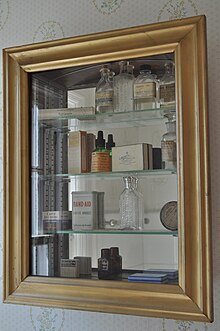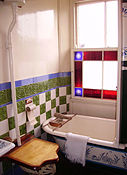Bathroom

A bathroom is a
Historically, bathing was often a collective activity, which took place in public baths. In some countries, the shared social aspect of cleansing the body is still important, for example with sento in Japan and, throughout the Islamic world, the hammam (also known in the West as a "Turkish bath").
Variations and terminology

The term for the place used to clean the body varies around the
In the United States, there is a lack of a single definition. This commonly results in discrepancies between the advertised and actual number of baths in real estate listings. Bathrooms are generally categorized as "master bathroom", containing a shower and a bathtub that is adjoining to the largest bedroom; a "full bathroom" (or "full bath"), containing four plumbing fixtures: a toilet and sink, and either a bathtub with a shower, or a bathtub and a separate shower stall; "half bath" (or "powder room") containing just a toilet and sink; and "3/4 bath" containing toilet, sink, and shower, although the terms vary from market to market. In some U.S. markets, a toilet, sink, and shower are considered a "full bath." In addition, there is the use of the word "bathroom" to describe a room containing a toilet and a basin, and nothing else.[citation needed]
In Canada, "washroom" is the preferred term for such a room, the same applies to public facilities.[4]
Design considerations
Towels
Bathrooms often have one or more towel bars or rings for hanging towels.[citation needed]
Furniture

Some bathrooms contain a bathroom cabinet for personal hygiene products and medicines, and drawers or shelves (sometimes in column form) for storing towels and other items.[5]
Bidet

Some bathrooms contain a bidet, which might be placed next to a toilet.[6]
Plumbing
The bathroom design must account for the use of hot and cold water, in significant quantities, for cleaning the body. The water is also used for moving solid and liquid human waste to a sewer or septic tank. Water may be splashed on the walls and floor, and hot humid air may cause condensation on cold surfaces. From a decorating point of view, the bathroom presents a challenge. Ceiling, wall, and floor materials and coverings should be impervious to water and readily and easily cleaned. The use of ceramic or glass, as well as smooth plastic materials, is common in bathrooms for their ease of cleaning. Such surfaces are often cold to the touch, however, so water-resistant bath mats or even bathroom carpets may be used on the floor to make the room more comfortable. Alternatively, the floor may be heated, possibly by strategically placing resistive electric mats under the floor tile or radiant hot water tubing close to the underside of the floor surface.[citation needed]
Electricity
Electrical appliances, such as lights, heaters, and heated towel rails, generally need to be installed as fixtures, with permanent connections rather than plugs and sockets. This minimizes the risk of
UK building regulations also define what type of electrical fixtures, such as light fittings (i.e. how water-/splash-proof) may be installed in the areas (zones) around and above baths, and showers.[8]
Lighting

Bathroom lighting should be uniform, and bright and must minimize glare. For all the activities like shaving, showering, grooming, etc. one must ensure equitable lighting across the entire bathroom space. The mirror area should have at least two sources of light at least 1 foot apart to eliminate any shadows on the face. Skin tones and hair color are highlighted with a tinge of yellow light. Ceiling and wall lights must be safe for use in a bathroom (electrical parts need to be splashproof) and therefore must carry appropriate certification such as
All forms of bathroom lighting should be IP44 rated as safe to use in the bathroom.[9][where?]
History
The first records for the use of baths date back as far as 3000 B.C. At this time water had a strong religious value, being seen as a purifying element for both body and soul. So it was not uncommon for people to be required to cleanse themselves before entering a sacred area. Baths are recorded as part of village or town life throughout this period, with a split between steam baths in Europe and America and cold baths in Asia. Communal baths were erected in a distinctly separate area from the living quarters of the village.[citation needed]
Nearly all of the hundreds of houses excavated had their bathing rooms. Generally located on the ground floor, the bath was made of brick, sometimes with a surrounding curb to sit on. The water drained away through a hole in the floor, down chutes or pottery pipes in the walls, and into the municipal drainage system. Even the fastidious Egyptians rarely had special bathrooms.[10]
Greek and Roman bathing

The Roman attitudes towards bathing are well documented; they built large thermal baths (
Not all ancient baths were in the style of the large pools that often come to mind when one imagines the
Both the Greeks and the Romans recognized the value of bathing as an important part of their lifestyles. Writers such as
16th century and beyond
Throughout the 16th, 17th, and 18th centuries, the use of
In Japan shared bathing in ]
Cultural historian Barbara Penner has written of the ambiguous nature of bathrooms as both the most private space and one most connected to the wider outside world.[11]
Gallery
-
Bathroom in Belgium
-
An early 20th century bathroom in the Beamish Museum, near Durham, England
-
Illustration of a bathroom from 1903
-
A bathroom in the Olympic village of the 2020 Winter Youth Olympics
See also
- Accessible toilet
- Folding screen
- Furo - Japanese bathroom
- Washstand
References
- ^ "bathroom". Marriam-Webster). Retrieved May 10, 2024.
- ISBN 9780979882036.
- ^ "The Benefits of a Jack and Jill Bathroom - Bob Vila". Bob Vila. Retrieved November 29, 2016.
- ^ "Washroom vs. restroom: Why do Canadians say one and Americans the other?". National Post. August 29, 2024. Retrieved August 29, 2024.
- ^ "Top 10 Bathroom Design Ideas". KitchenCarpets.com. August 13, 2024. Retrieved August 13, 2024.
- ^ "Why You Should Buy a Bidet". TheSpruce. June 13, 2024. Retrieved September 7, 2024.
- ^ "The Plugs and Sockets etc. (Safety) Regulations 1987". Legislation UK.
- ^ "Bathroom Zones and IP Ratings Explained". Bathrooms.
- ^ "Lighting research center - Bathroom lighting". Article from lighting research center at Rensselaer Polytechnic Institute (Troy, NY 12180 USA). Rensselaer Polytechnic Institute. Archived from the original on September 7, 2011. Retrieved July 10, 2011.
- ISBN 0-684-83718-8.
- )
Further reading
- ISBN 9780679426790.
- Hoagland, Alison K. (2018). The Bathroom: A Social History of Cleanliness and the Body. ISBN 9781440852664.
External links
 Media related to Bathroom at Wikimedia Commons
Media related to Bathroom at Wikimedia Commons




